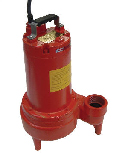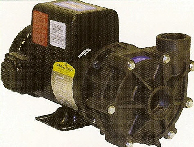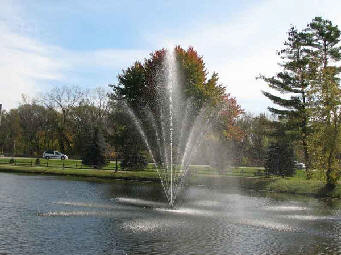Types of Pond Pumps
Pond Pump
A pond pump is an important part of a fish pond or water feature. Each feature requires the water to circulate via a water pump. There are a few types of pond pumps available, each with their own feature and performance chart. We'll help you decide which type of pump may be best for your application.
|
|
First, there are two types of pond pumps. A submersible pump needs to operate while submersed in the water. If it is brought up above the water while in operation, the pump will burn out and stop working. This type of pump may be used in a fountain, a pond or a variety of water features that require a pump to push water from one point to another. There are a variety of submersible pumps based on the type of volume needed. This is mostly used for very large submersible pumps and not your typical backyard pond pump.
The second type of pond pump is a non-submersible pump also known as an external pump or a centrifugal pump. All terms are used interchangeable. Some folks even refer to it as an above ground pump. Whatever you call it, these pumps do not operate while being submersed. |
| So, why would you decide on a submersible or centrifugal pump? You would first need to decide why you want the pump and how best to achieve it's purpose. A submersible water pump can be easily hidden in a pond or a skimmer. Conveniently located in the water, it simply sucks in water from the pond and pushes it to a waterfall, a fountain, a fountain spitter, a pond filter or some type of water feature. The advantage of having a submersible pump is that it can be hidden and you won't hear it operating. Most pumps are also black in color so they can be hidden within the fish pond easily. The disadvantage of having a submersible pump is that you will most likely need to get into the pond whether reaching your hand down in the skimmer to get it or plan on getting wet by getting in the pond to retrieve it should something ever go wrong with it or you need to remove it for the winter. |
|
The advantages of having an external pond pump or non-submersible pump is that it is located outside of the pond, can be easily worked on or removed without having to get wet. Plumbing it to a pond UV filter or other type of apparatus is also easier if it's located outside of the pond. The drawback, is that you very well may hear it hum while it works. There are however, fake rock covers that work very well in not only camouflaging the pump but in eliminating or reducing the hum noise while it's operating.
A non-submersible or centrifugal pump also have a unique advantage in that for very large pond waterfalls or water features, centrifugal pumps offer a much higher volume or higher pressure than what submersible pumps can offer. So, if you want a very large water feature or if you're into fish farming and raise a variety of fish, then a centrifugal pump is definitely what you will need.
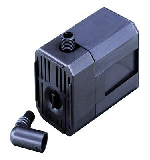 Small Fountain Pump |
There are also fountain pumps which can be for small statuaries or small fountains or those for large lakes that shoot a huge spray pattern up in the air. We often refer to these as just fountains but they do come with a pump that is needed to push the water through.
To install a pond pump, you will need to make certain that you have an electrical outlet that has enough amps to power your water pump. This outlet will need to have a GFI or GFCI (Ground Fault Interupter) feature. This is to protect anyone coming into contact with the water should the pump from electrical shock should the pump ever short out. |
Typically, manufacturers make the electrical cord for the garden pond pump up to 20 feet long. Be sure to check with your city ordinance how far away from the pond's edge you can install electricity and then take into account exactly where you want your pump to make sure the cord is long enough to reach the outlet.
Every pond pump comes with a performance chart that will indicate how much water flow that pump will provide at a certain distance and height. Typically, this is referred to in gallons per minute (GPM) or gallons per hour (GPH). There is a bit of math you need to go through in order to know what type of water pond pump you will need for your application. We cover all of this in our online course, 'how to build a pond'. Be sure to check it out.
| In jist, you will need to determine what size of pond pump you need for your application. This is determined by how far you want the pump to push the water and how high you want to push it. It's very, very important to know that manufacturer's will list their pump on the front of the box usually at the highest GPH that pump provides. This performance will NOT be the same if you want that same pond pump to push water 50 feet away and 10 feet high - if it would even make it. So, be sure to check out the performance chart for the garden pond pump in order to make sure you get the correct size.
Also, do know that most businesses selling pond pumps probably don't know the first thing about determining what size of pump is right for your water feature. There is math involved. It's not just looking at the performance chart on the box and 'guessing'. Let us help you determine what size of pond pump you need. |
|
Also, be wary of the horsepower of the water pond pump. Horsepower has almost nothing to do with what size of pump may be right for you. Manufacturer's are continually making pumps more energy efficient, thereby requiring less horsepower to do an even greater job. So, don't look at the horsepower for a pump when considering if it's large enough to do the job. Horsepower isn't quite like what it used to be.
Often times people look for solar pond pumps. They can be convenient because they don't require electricity to operate. This may be advantageous for ponds located quite a distance for a power source. Their drawback though, is that they are unreliable. If you have cloudy days, they don't get enough energy to provide power to operate. If you have pond fish that need oxygenation from this solar pump and the pump is not working because it's cloudy outside, well, you may very well lose your fish.
Some folks also try to use swimming pool pumps for their ponds or sump pumps. These pumps are not designed for either continuous use or for the particles of debris that is found in a fish pond compared to a much cleaner swimming pool. Be sure you get the right type of pump. Trying to cut corners in price may very well cost you in other places - particularly if you have fish that are dependent on the oxygenation that a pump can provide.
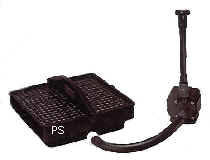 |
As mentioned above about horsepower, another thing to note about pond pumps is that a more energy efficient magnetic drive pumps have been created that are very energy efficient. Some, can even be used as a submersible pump or as an external one. So, be sure to check out magnetic drive pumps.
Again, be wary of other sites on the internet who are selling pond pumps along with other pond supplies. Often times these folks don't know the first thing about how to calculate what size of pump you need or anything else regarding designing a pond. They simply steal text from other sites (such as ours), have someone else who doesn't know a thing about ponds write an article that is based on keywords for search engines and does not necessarily contain factual information. This is so their results will get higher in the search engines and they'll be able to sell you something like a pond pump or some other type of pond product. The internet is literally filled with such articles. Let us at Pond Solutions help you with your pond or water feature project. You'll sure to get expert advice and the best products to do the job right - the first time! |
If you're feeling like you want to do a little math, I will quickly tell you part of the information on how to determine what size of pond pump you need for your water feature.
First, measure the horizontal distance you want your water pump to push water. Then, measure the height from the top of the pond's surface to the height of your waterfall, pond filter or wherever you want the pump to push water to.
Now, for every 10 feet of horizontal distance you want the pond pump to push water, you add one foot of something that is called a 'lift'. So, if you want it to push water for 20 feet, this equates to a 2 foot lift.
For every foot in vertical height you want the pond pump to push water, you add 1 foot of lift. So, if you want to push the water 5 feet up in the air, this is a 5 foot lift.
Now, add all the 'lifts' for your pond pump together and this is your total. With the above example, we had a 2 foot horizontal lift and a 5 foot vertical lift. This equals to 7 feet of lift. Once you have determined how much pressure you need in GPH or GPM, (covered in our how to build a pond online course) you will need to add this 'lift' to the GPH. Just for the sake of an example, say you have calculated that your garden pond pump needs to push 750 GPH - but the critical information that most people don't know about (besides calculating the GPH they need) is that you need to add the lifts to this number. You may need a pump that pushes 750 GPH at a 7 foot lift. You will need to look at the performance charts of each water pump to see which one will provide this pressure. It 'may' be a box that is listed as a 1150 GPH pump because as I mentioned above, this is the optimal amount that pump may perform at a 0 or 1' lift - but, you need to pump water at a 7' lift - right? So, that 1150 GPH water pump may provide 1150 GPH at 0 or 1' lift, 900 GPH at a 3' lift, and 750 GPH at a 7' lift. So, the lifts and calculating out what size of water pump you need is critical to having enough pressure for your water feature.
At PondSolutions.com we're happy to help you select which type of pond pump you need for your application. There is a bit involved in deciding what type of water pump or waterfall pump is right for you but once this is determined, you'll be certain that the pond pump will perform just as you wanted it to and won't either be too powerful or have too little pressure to provide you with water feature or filtration you need for your pond.

